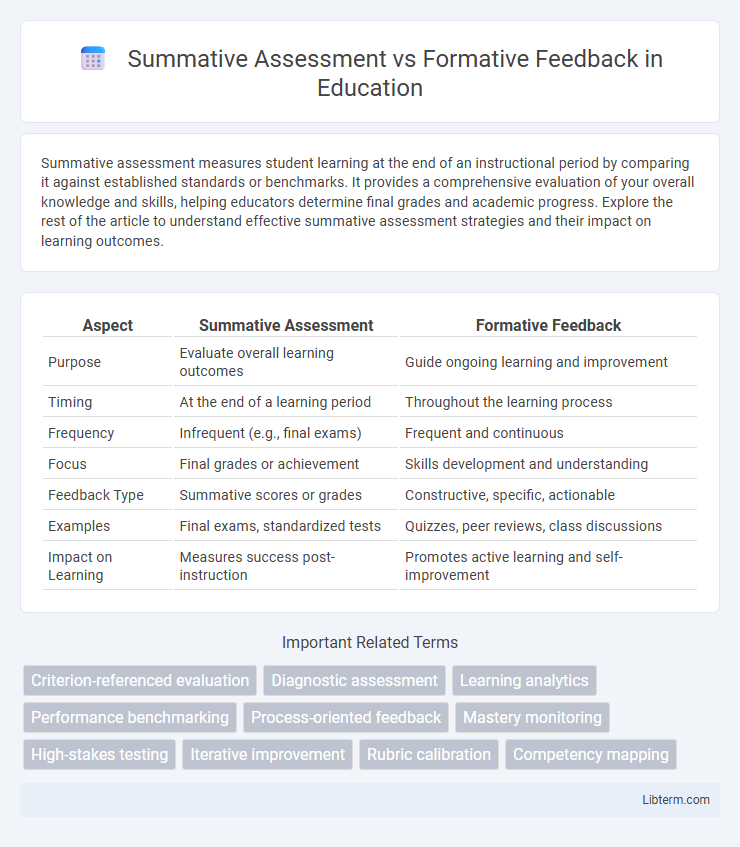Summative assessment measures student learning at the end of an instructional period by comparing it against established standards or benchmarks. It provides a comprehensive evaluation of your overall knowledge and skills, helping educators determine final grades and academic progress. Explore the rest of the article to understand effective summative assessment strategies and their impact on learning outcomes.
Table of Comparison
| Aspect | Summative Assessment | Formative Feedback |
|---|---|---|
| Purpose | Evaluate overall learning outcomes | Guide ongoing learning and improvement |
| Timing | At the end of a learning period | Throughout the learning process |
| Frequency | Infrequent (e.g., final exams) | Frequent and continuous |
| Focus | Final grades or achievement | Skills development and understanding |
| Feedback Type | Summative scores or grades | Constructive, specific, actionable |
| Examples | Final exams, standardized tests | Quizzes, peer reviews, class discussions |
| Impact on Learning | Measures success post-instruction | Promotes active learning and self-improvement |
Understanding Summative Assessment
Summative assessment evaluates student learning at the end of an instructional period by measuring mastery of specific learning objectives through exams, final projects, or standardized tests. It provides quantitative data used for grading, credentialing, and curriculum evaluation, often lacking detailed feedback for learning improvement. Understanding summative assessment requires recognizing its role in accountability and proficiency measurement rather than guiding ongoing student development.
Defining Formative Feedback
Formative feedback is a continuous, interactive process aimed at improving student learning by providing specific, actionable insights during the instructional period. It emphasizes real-time guidance and constructive comments to help learners identify strengths and areas for improvement before final evaluations. This type of feedback supports adaptive teaching strategies and promotes deeper understanding, contrasting with summative assessment's focus on final outcomes.
Key Differences Between Summative and Formative Approaches
Summative assessment evaluates student learning at the end of an instructional period, providing a final judgment primarily through tests, exams, or projects, while formative feedback occurs continuously during the learning process to guide improvement and enhance understanding. Summative assessments are typically graded and aim to measure competency against standards, whereas formative feedback is descriptive, ungraded, and designed to identify strengths and areas for growth. The key difference lies in their purpose: summative assessment assesses learning outcomes, whereas formative feedback supports ongoing learning and development.
Purposes and Goals of Assessment Types
Summative assessment aims to evaluate student learning by measuring mastery of content at the end of an instructional period, providing a benchmark for grading and academic progress. Formative feedback focuses on ongoing improvement by identifying strengths and weaknesses during the learning process, guiding instructional adjustments and personalized support. The primary goal of summative assessment is to certify achievement, whereas formative feedback seeks to enhance learning through continuous reflection and intervention.
Timing and Frequency of Feedback
Summative assessment occurs after instruction, providing an evaluative summary of student learning typically at the end of a unit or course, with feedback delivered infrequently. Formative feedback happens continuously during the learning process, allowing for real-time adjustments and improvements through frequent, ongoing input. Timely formative feedback enhances learning by identifying gaps early, while summative assessment results guide final grading and overall performance evaluation.
Impact on Student Learning and Motivation
Summative assessment provides a comprehensive evaluation of student learning at the end of an instructional period, often influencing final grades and academic outcomes. Formative feedback, delivered during the learning process, offers timely insights that help students identify strengths and areas for improvement, fostering continuous growth. Research shows formative feedback significantly enhances student motivation by promoting a growth mindset and encouraging active engagement with the material.
Common Methods of Summative Assessment
Common methods of summative assessment include standardized tests, final exams, end-of-term projects, and cumulative portfolios that evaluate student learning at the conclusion of an instructional period. These assessments measure the extent to which educational objectives and learning outcomes have been achieved, providing quantifiable data for grading and accountability. Summative assessments contrast with formative feedback by emphasizing performance evaluation rather than ongoing improvement and instructional adjustment.
Effective Strategies for Formative Feedback
Effective formative feedback strategies include providing specific, actionable comments that guide student improvement and using frequent, low-stakes assessments to monitor progress. Incorporating dialogic feedback encourages student reflection and active engagement in their learning process. Utilizing technology tools like learning management systems can streamline timely feedback delivery, enhancing personalized learning experiences.
Integrating Summative and Formative Practices
Integrating summative assessment with formative feedback enhances student learning by combining comprehensive evaluation with ongoing instructional support. Summative assessments provide data-driven benchmarks that inform targeted formative feedback, enabling educators to tailor interventions and promote mastery of learning objectives. This synergy fosters continuous improvement and effective measurement of both student achievement and instructional efficacy.
Choosing the Right Assessment Approach
Choosing the right assessment approach involves understanding the distinct roles of summative assessment and formative feedback in the learning process. Summative assessments, such as final exams or standardized tests, evaluate student learning at the end of an instructional period and provide measurable outcomes for grading and accountability. Formative feedback, delivered continuously through quizzes, observations, and interactive activities, guides student improvement and informs instructional adjustments, promoting deeper understanding and skill development.
Summative Assessment Infographic

 libterm.com
libterm.com